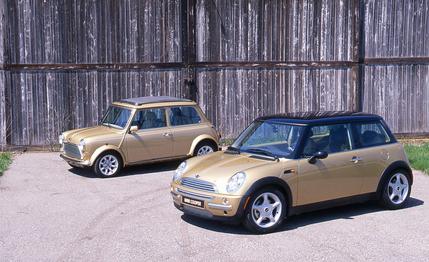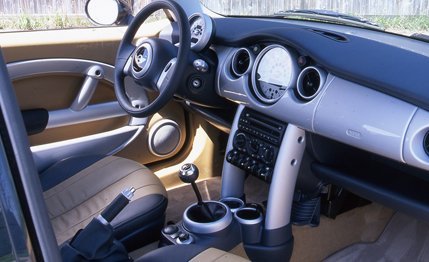 First Drive Review
First Drive Review
The original Mini, introduced in 1959, sold 5.3 million units over the course of 41 years. Park all of them end to end, and you'd have a line of Minis that stretch from New York to Singapore. Impressive as those numbers are, they're not the whole story of the significance of the original Mini (first called the Austin Seven and the Morris Mini Minor). Would you judge the significance of the Gutenberg printing press by the number of them that were sold? Consider this: Chevrolet has sold 5.4 million Cavaliers in 20 years. Imagine the Cavalier surviving unchanged for 40 years. Imagine Cavalier clubs, racing Cavaliers, a notably short skirt named after the Cavalier. Imagine a queen knighting the Cavalier's designer. So the Mini has a long cultural history. But even in Britain, a country unusually proud of its past, symbols of a once-glorious empire must give way to modernity. The devotion of the Brits kept alive the Mini, a car considered mechanically outdated 20 years ago. But by the early '80s, only about 5000 Minis were trundling out of showrooms every year. So although devotion to the Mini as an icon of Britishness remained strong, devotion to the Mini-the car-has long since passed.
Two feet longer than the classic Mini, the new also has an upscale interior, in contrast to the austerity of the original.
Take a look at the 2002 Mini Cooper, and all its styling cues hearken back to 1959. It evokes images of '60s swinging London and Monte Carlo Rally wins. But look beyond the big round headlamps, the chrome grille, and the characteristic Mini Cooper contrasting-color roof, and you'll see a modern BMW in all but name and drivetrain layout. The new Mini began as a joint project between Rover, the car's last owner, and BMW, its current parent. In the end, though, the Germans took over, reengineering the works, from its half-shafts to its floorpan. Gone is the light, runabout character of the original, replaced by the substantive, capable feel that we've come to identify with German craftsmanship.

BMW says the structure of the Mini is between 1.5 and 3.0 times stiffer than that of its competitors and 50 percent stiffer than its own line of 3-series cars. The Mini's small dimensions help in that regard, but so do the 3800 welds on the structure (the much larger 3-series has only 800 more). BMW bolted to this rigid structure a much more sophisticated suspension than is found in most cars. The rear suspension mimics the multilink arrangement of the current 3-series. A simpler, cheaper rear suspension would have saved more space, but this is a fun car, and BMW has made certain sacrifices to achieve that mission. The front uses struts. Our test car was equipped with the Sport suspension (stiffer than the standard setup but softer than the "Sport Suspension Setting Plus"). The sport-tuned suspension allows virtually no body roll, even when pushed hard on the tight, twisting roads of central Italy where we drove the car. It feels as if the Mini's center of gravity were a foot below the pavement.
The front-end grip, even with the standard 15-inch wheels and modest 175/65 Pirelli performance tires, is nothing short of amazing. Unless you go barreling into a corner stupid-fast, the Mini resolutely refuses to understeer. Even on some unexpected decreasing-radius turns, we just dialed in more steering and the front tightened the car's line. Lovely. The steering, too, is lovely, certainly for a front-driver. It provides ample feel, no torque steer, and impressive accuracy. We'll reserve judgment on the Mini Cooper's ride quality until we get one on our cracked and pocked roads. We can say that sport-suspension-equipped Minis are plenty stiff and suffer some short-wheelbase choppiness. As stiff as it is, the new Mini never feels crude. This is a premium small car. Very little engine vibration can be felt through the steering wheel or pedals. High-speed stability is excellent, but there is more road noise than in other BMWs.